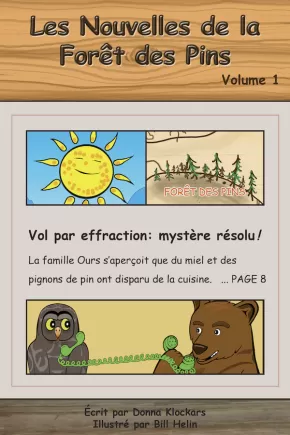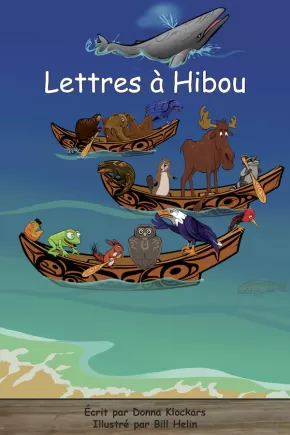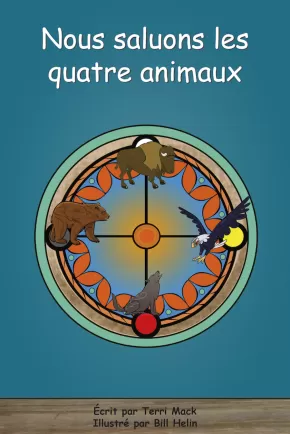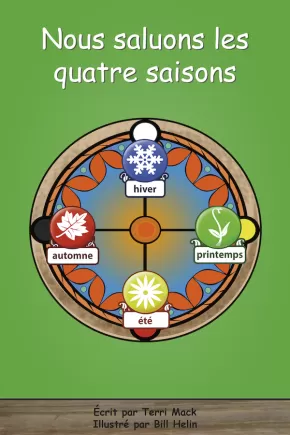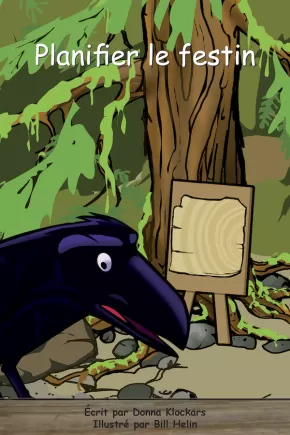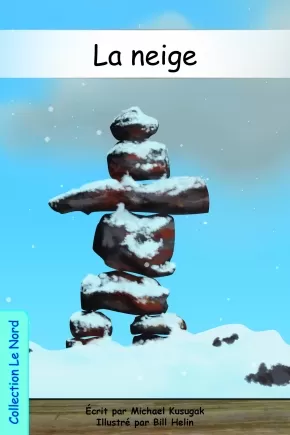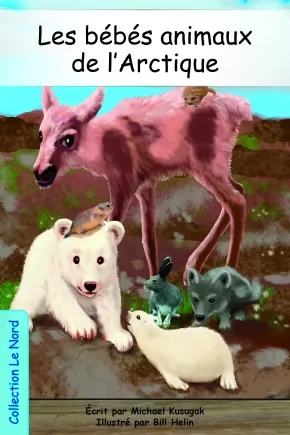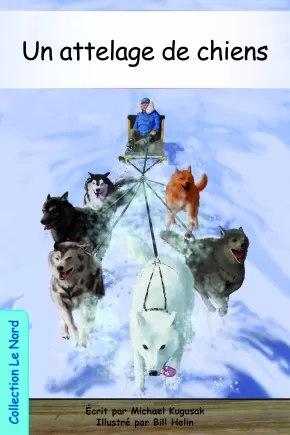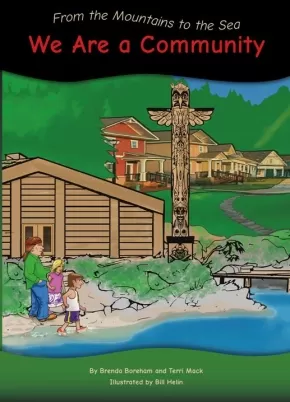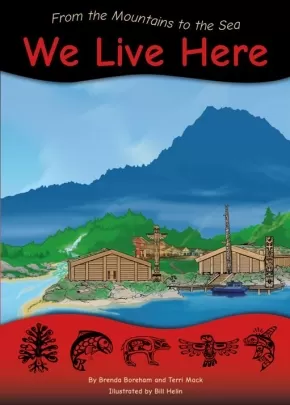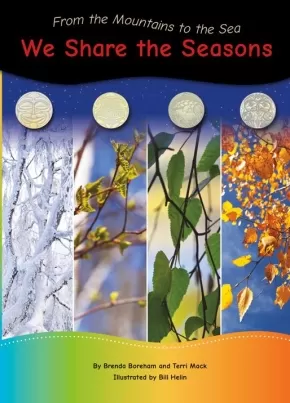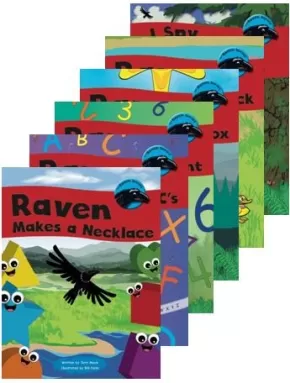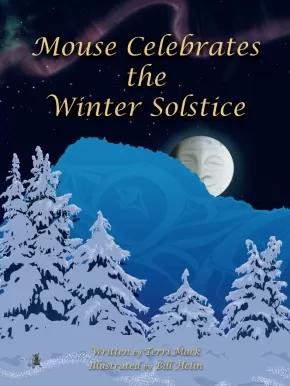
Bill Helin
Bill Helin is of Tlingit, Tsimshian, and Norwegian descent and is a member of the Tsimshian Nation, born and raised in the Northwest coastal community of Prince Rupert, British Columbia. His father was Arthur Helin; his grandfather, Henry William Helin, was Chief of the Gitlan Tribe; and his grandmother, Maud Helin, was Chief of the Gitgeese Tribe. Bill spent many hours listening to his grandmother’s stories of the Tsimshian People. He was amusing his family, friends, and teachers with caricatures and cartoons at a young age. Bill has illustrated many children’s books published by Strong Nations.
Kids Books (15)
Collection Lecteurs forts - B : Les Nouvelles de la Forêt des Pins (N20)
 $11.50
$11.50

Artists:
Format:
Paperback
Grade Levels: 2;
ISBN / Barcode: 9781771744386
Synopsis:
Synopsis:
Lorsqu’ils lisent le journal, les gens se renseignent au sujet d’évènements importants. Tous les animaux de la Forêt des Pins aiment lire les nouvelles. Pouvez-vous prédire quelles histoires les animaux journalistes pourraient écrire dans « Nouvelles de la Forêt des Pins » ?
Educator & Series Information / Information pour éducateurs
Les Nouvelles de la Forêt des Pins fait partie de la collection des Lecteurs forts : ensemble B. Ensemble B est la suite de l'ensemble A et continue sur les aventures de Grenouille, Ours, Aigle, et Corbeau avec une mélange de livres de fiction et de non-fiction nivelés de 11 à 20. Les Nouvelles de la Forêt des Pins est de niveau 20.
Les Lecteurs forts font partie d'une collection de lecture nivelée intégré avec des liens vers la science, la numératie, la responsabilité sociale, les arts de langage, et les enseignements de la langue orale. Les livres comprennent du texte échafaudé et des stratégies de lecture. Ils ont soit des illustrations de l'artiste Tsimshian Bill Helin, soit des photos. La collection entière est interconnectée et suit les valeurs culturelles de Grenouille, Ours, Aigle, et Corbeau.
Cette ressource est aussi disponible en anglais : Pine Forest News.
Additional Information / Information additionnelle:
Dimensions : 6" x 9" | 16 pages | ISBN : 9781771744386
Collection Lecteurs forts - B : Les oiseaux-mouches (N19)
 $11.50
$11.50

Artists:
Format:
Paperback
Grade Levels: 2;
ISBN / Barcode: 9781771744164
Synopsis:
Synopsis:
Les oiseaux-mouches sont des oiseaux absolument incroyables. Ils peuvent voler dans tous les sens : vers le haut, le bas, en avant, en arrière et même de côté. Ils peuvent aussi voler sur place. L’oiseau-mouche est le seul oiseau au monde capable de voler à reculons. Avez-vous déjà vu un oiseau-mouche ? Qu’est-ce que vous avez remarqué en l’observant ?
Educator & Series Information / Information pour éducateurs
Les oiseaux-mouches fait partie de la collection des Lecteurs forts : ensemble B. Ensemble B est la suite de l'ensemble A et continue sur les aventures de Grenouille, Ours, Aigle, et Corbeau avec une mélange de livres de fiction et de non-fiction nivelés de 11 à 20. Les oiseaux-mouches est de niveau 19.
Les Lecteurs forts font partie d'une collection de lecture nivelée intégré avec des liens vers la science, la numératie, la responsabilité sociale, les arts de langage, et les enseignements de la langue orale. Les livres comprennent du texte échafaudé et des stratégies de lecture. Ils ont soit des illustrations de l'artiste Tsimshian Bill Helin, soit des photos. La collection entière est interconnectée et suit les valeurs culturelles de Grenouille, Ours, Aigle, et Corbeau.
Cette ressource est aussi disponible en anglais : Hummingbirds.
Additional Information / Information additionnelle
Dimensions : 6" x 9" | 16 pages | ISBN : 9781771744164
Collection Lecteurs forts - B : Lettres à Hibou (N18)
 $11.50
$11.50

Artists:
Format:
Paperback
Grade Levels: 2;
ISBN / Barcode: 9781771744300
Synopsis:
Synopsis:
Tous les animaux se préparent pour le festin d’été. Certains ont de difficulté à compléter leur travail. Hibou a la réputation de savoir comment aider ses amis à résoudre des problèmes. Les animaux écrivent alors des lettres à Hibou pour lui demander de l’aide. Pouvez-vous prédire quels problèmes Hibou aidera à résoudre ? Comment faites-vous pour résoudre des problèmes ?
Educator & Series Information / Information pour éducateurs
Lettres à Hibou fait partie de la collection des Lecteurs forts : ensemble B. Ensemble B est la suite de l'ensemble A et continue sur les aventures de Grenouille, Ours, Aigle, et Corbeau avec une mélange de livres de fiction et de non-fiction nivelés de 11 à 20. Lettres à Hibou est de niveau 18
Les Lecteurs forts font partie d'une collection de lecture nivelée intégré avec des liens vers la science, la numératie, la responsabilité sociale, les arts de langage, et les enseignements de la langue orale. Les livres comprennent du texte échafaudé et des stratégies de lecture. Ils ont soit des illustrations de l'artiste Tsimshian Bill Helin, soit des photos. La collection entière est interconnectée et suit les valeurs culturelles de Grenouille, Ours, Aigle, et Corbeau.
Cette ressource est aussi disponible en anglais : Letters to Owl.
Additional Information / Information additionnelle
Dimensions : 6" x 9" | 16 pages | ISBN : 9781771744300
Collection Lecteurs forts - B : Nous saluons les quatre animaux (N16)
 $11.50
$11.50

Artists:
Format:
Paperback
Text Content Territories:
Indigenous Canadian;
Grade Levels: 1;
ISBN / Barcode: 9781771744362
Synopsis:
Synopsis:
La roue de médecine est un guide pour vivre une vie saine. Les gens l’utilisent dans tous les coins du monde. Il y a quatre parties dans la roue de médecine; chacune nous enseigne quelque chose de différent. Tout ce qui nous entoure nous enseigne quelque chose. Nous commençons nos leçons dans la direction où le soleil se lève, à l’est. Les cadeaux des quatre animaux nous enseignent beaucoup. Que savez-vous déjà à propos des quatre animaux ?
Educator & Series Information / Information pour éducateurs
Nous saluons les quatre animaux fait partie de la collection des Lecteurs forts : ensemble B. Ensemble B est la suite de l'ensemble A et continue sur les aventures de Grenouille, Ours, Aigle, et Corbeau avec une mélange de livres de fiction et de non-fiction nivelés de 11 à 20. Nous saluons les quatre animaux est de niveau 16.
Les Lecteurs forts font partie d'une collection de lecture nivelée intégré avec des liens vers la science, la numératie, la responsabilité sociale, les arts de langage, et les enseignements de la langue orale. Les livres comprennent du texte échafaudé et des stratégies de lecture. Ils ont soit des illustrations de l'artiste Tsimshian Bill Helin, soit des photos. La collection entière est interconnectée et suit les valeurs culturelles de Grenouille, Ours, Aigle, et Corbeau.
Cette ressource est aussi disponible en anglais : We Greet the Four Animals.
Additional Information / Information additionnelle
Dimensions : 6" x 9" | 16 pages | ISBN : 9781771744362
Collection Lecteurs forts - B : Nous saluons les quatre saisons (N19)
 $11.50
$11.50

Artists:
Format:
Paperback
Text Content Territories:
Indigenous Canadian;
Grade Levels: 2;
ISBN / Barcode: 9781771744447
Synopsis:
Synopsis:
La roue de médecine est un guide vers une vie saine. Les gens l’utilisent partout au monde. Chacune des quatre parties de la roue de médecine nous enseigne quelque chose de différent. Nous apprenons à partir de tout ce qui nous entoure ! Nous commençons nos apprentissages dans la direction où le soleil se lève, à l’est. Les cadeaux des quatre saisons nous enseignent beaucoup. Que savez-vous déjà au sujet des quatre saisons ?
Educator & Series Information / Information pour éducateurs
Nous saluons les quatre saisons fait partie de la collection des Lecteurs forts : ensemble B. Ensemble B est la suite de l'ensemble A et continue sur les aventures de Grenouille, Ours, Aigle, et Corbeau avec une mélange de livres de fiction et de non-fiction nivelés de 11 à 20. Nous saluons les quatre saisons est de niveau 19.
Les Lecteurs forts font partie d'une collection de lecture nivelée intégré avec des liens vers la science, la numératie, la responsabilité sociale, les arts de langage, et les enseignements de la langue orale. Les livres comprennent du texte échafaudé et des stratégies de lecture. Ils ont soit des illustrations de l'artiste Tsimshian Bill Helin, soit des photos. La collection entière est interconnectée et suit les valeurs culturelles de Grenouille, Ours, Aigle, et Corbeau.
Cette ressource est aussi disponible en anglais : We Greet the Four Seasons.
Additional Information / Information additionnelle
Dimensions : 6" x 9" | 16 pages | ISBN : 9781771744447
Collection Lecteurs forts - B : Planifier le festin (N14)
 $11.50
$11.50

Artists:
Format:
Paperback
Grade Levels: 1;
ISBN / Barcode: 9781771744201
Synopsis:
Synopsis:
Il y aura bientôt un grand festin d’été dans la Forêt des Pins. Corbeau a de grands plans. Qu’est-ce que les animaux pourraient préparer à l’avance ? Pensez-vous que Corbeau sera un bon planificateur ?
Educator & Series Information / Information pour éducateurs
Planifier le festin fait partie de la collection des Lecteurs forts : ensemble B. Ensemble B est la suite de l'ensemble A et continue sur les aventures de Grenouille, Ours, Aigle, et Corbeau avec une mélange de livres de fiction et de non-fiction nivelés de 11 à 20. Planifier le festin est de niveau 14.
Les Lecteurs forts font partie d'une collection de lecture nivelée intégré avec des liens vers la science, la numératie, la responsabilité sociale, les arts de langage, et les enseignements de la langue orale. Les livres comprennent du texte échafaudé et des stratégies de lecture. Ils ont soit des illustrations de l'artiste Tsimshian Bill Helin, soit des photos. La collection entière est interconnectée et suit les valeurs culturelles de Grenouille, Ours, Aigle, et Corbeau.
Cette ressource est aussi disponible en anglais : Planning the Feast.
Additional Information / Information additionnelle
Dimensions : 6" x 9" | 16 pages | ISBN : 9781771744201
Collection Lecteurs Forts - Le Nord: Je construis un iglou
 $10.95
$10.95

Artists:
Format:
Paperback
Text Content Territories:
Indigenous Canadian; Inuit;
Grade Levels: 1;
ISBN / Barcode: 9781771741484
Synopsis:
Synopsis:
Présentation du livre de couverture: Dans ce livre tu vas apprendre à construire un iglou. C’est très important de faire les blocs de la bonne taille et forme. Les blocs sont des rectangles. Comment penses-tu que Michael Kusugak appris à construire un iglou ?
Educator & Series Information
This book is part of the Strong Readers Northern Series. The Northern Series includes a mixture of fiction and non-fiction books that provide cultural reflections of the Inuit.
This resource is also available in English: I Build An Igloo.
Additional Information
ISBN: 9781771741484
Collection Lecteurs forts - Le Nord: La neige
 $10.95
$10.95

Artists:
Format:
Paperback
Text Content Territories:
Indigenous Canadian; Inuit;
Grade Levels: 1;
ISBN / Barcode: 9781771741460
Synopsis:
Synopsis:
Présentation du livre de couverture: Ce livre parle de la neige. Il y a différents types de neige dans le nord. Qu’est-ce que tu sais à propos de la neige ? Qu’est-ce que tu peux faire dans la neige ?
Educator & Series Information
This book is part of the Strong Readers Northern Series. The Northern Series includes a mixture of fiction and non-fiction books that provide cultural reflections of the Inuit.
This resource is also available in English: Snow.
Additional information
ISBN: 9781771741460
Collection Lecteurs forts - Le Nord: Les bébés animaux de l’Arctique
 $10.95
$10.95

Artists:
Format:
Paperback
Grade Levels: 1;
ISBN / Barcode: 9781771741477
Synopsis:
Synopsis:
Présentation du livre de couverture: Ce livre parle des animaux qui habitent l’Arctique. Observe la couverture de ce livre. Combien d’animaux vois-tu ? Tu peux les nommer ?
Educator & Series Information
This book is part of the Strong Readers Northern Series. The Northern Series includes a mixture of fiction and non-fiction books that provide cultural reflections of the Inuit.
This resource is also available in English: Baby Arctic Animals.
Additional Information
ISBN: 9781771741477
Collection Lecteurs forts - Le Nord: Un attelage de chiens
 $10.95
$10.95

Artists:
Format:
Paperback
Text Content Territories:
Indigenous Canadian; Inuit;
Grade Levels: Kindergarten;
ISBN / Barcode: 9781771741446
Synopsis:
Synopsis:
Présentation du livre de couverture: Ce livre nous parle d’un attelage de chiens. Le chien qui est devant est le chien de tête de l’attelage. Les chiens de l’attelage travaillent ensemble pour tirer le traîneau. Qu’est-ce que tu remarques à propos de ces chiens ?
Educator & Series Information
This book is part of the Strong Readers Northern Series. The Northern Series includes a mixture of fiction and non-fiction books that provide cultural reflections of the Inuit.
This resource is also available in English: A Dog Team.
Additional Information
ISBN: 9781771741446
From the Mountains to the Sea: We Are a Community
 $29.95
$29.95

Artists:
Format:
Paperback
Text Content Territories:
Indigenous Canadian;
Grade Levels: 2;
ISBN / Barcode: 9781771741033
Synopsis:
Synopsis:
Each book in the series, From the Mountains to the Sea, supports the new BC Aboriginal Learning Standards in both Science and Social Studies.
Click link to download a Grade 2 five-week planning guide: Grade 2 FREE Download for We Are a Community
Back of book introduction:
From the Mountains to the Sea: We Are a Community is a Grade 2 resource, which covers all of your Aboriginal Learning Standards in both science and social studies within the new BC curriculum.
This book is about a river. Most rivers start high up in the mountains. As the water comes downhill, it makes little pathways in the rocks and gravel. As the pathways get bigger, they join to make streams. When several streams join, they make a river. Some rivers have waterfalls and deep pools. In some places, fast moving water tumbles over rocks forming rapids. When a river leaves the mountain for flatter ground it starts to slow down. Eventually, a river ends when it flows into the sea. Where the fresh water and the salt water meet is an estuary. Have you ever been to an estuary?
The area in and around an estuary is a good place for plants, animals and people to live because we can all find food and water there. The salmon is an important food for many of us. Have you ever eaten salmon?
People have paid attention to the life cycle of salmon for thousands of years. We have learned that sometimes we can help salmon survive by building a salmon hatchery along a river. Some hatcheries are huge while others are quite small. Have you ever visited a salmon hatchery?
There are many sizes of rivers in the world. Some are wide. Some are narrow. Some are deep. Some are shallow. Do you live near a river? What plants and animals have you seen there?
This book is also part of a bundled package that includes:
- a card game: matching and sequencing
- a CD
- bulletin board trimmers
Click here to view the bundle: From the Mountains to the Sea: We Are a Community Bundle
This resource is available in French: Collection Des montagnes à la mer: Nous sommes une communauté
Additional Information
Book dimensions: 10" x 14" | Pages: 16 | ISBN: 9781771741033
From the Mountains to the Sea: We Live Here
 $29.95
$29.95

Artists:
Format:
Paperback
Text Content Territories:
Indigenous Canadian;
Grade Levels: Kindergarten;
ISBN / Barcode: 9781771741019
Synopsis:
Synopsis:
Each book in the series, From the Mountains to the Sea, supports the new BC Aboriginal Learning Standards in both Science and Social Studies.
From the Mountains to the Sea: We Live Here is a Kindergarten resource, which covers all of your Aboriginal Learning Standards in both science and social studies within the new BC curriculum.
Click link to download a five-week Kindergarten planning guide: Kindergarten FREE Download for We Live Here
Back of book introduction:
This book is about a river. Can you find a river on the front cover of this book? What do you know about rivers?
Most rivers start high up in the mountains. As the water comes down the hill, it makes little pathways in the rocks and gravel. As the pathways get bigger, they join to make streams. Sometimes the streams join together to make a river. Where a river leaves the mountains the ground flattens out, and the river slows down. The river ends when it flows into the sea.
The area in and around a river is a good place for plants, animals and people to live because we can all find food and water there. The salmon is an important food for many of us.
Some of the plants and animals that you will find in this book are:
- Cedar trees live and grow all the way along a river, from the mountains to the sea.
- Salmon spend their adult lives out in the open sea. When it is time to lay their eggs, they swim back to their home streams. Their home streams are sometimes very close to the mountains.
- Bears walk long distances to find their food. They live from the mountains to the sea. In the fall they go to the rivers to fish for salmon.
- Eagles fly over large areas looking for food. They live from the mountains to the sea. In the fall, they go to the rivers to feast on salmon.
- Orcas live in the open sea. They swim long distances to hunt for food. Some orcas eat salmon.
This book is also part of a bundled package: From the Mountains to the Sea: We Live Here Bundle
This resource is available in French: Collection Des montagnes à la mer: Nous habitons ici
Additional Information
Book dimensions: 10" x 14" | Pages: 16 | ISBN: 9781771741019
From the Mountains to the Sea: We Share the Seasons
 $29.95
$29.95

Artists:
Format:
Paperback
Text Content Territories:
Indigenous Canadian;
Grade Levels: 1;
ISBN / Barcode: 9781771741026
Synopsis:
Synopsis:
Each book in the series, From the Mountains to the Sea, supports the new BC Aboriginal Learning Standards in both Science and Social Studies.
Click link to download a five-week Grade 1 planning guide: Grade 1 FREE Download for We Share the Seasons
Back of book introduction:
From the Mountains to the Sea: We Share the Seasons is a Grade 1 resource, which covers all of your Aboriginal Learning Standards in both science and social studies within the new BC curriculum.
This book is about the changing seasons in and along a riverbank, from the mountains to the sea. You will see many plants and animals that live along a riverbank. They grow and change just as we do.
A season is one of the four parts of the year: winter, spring, summer and fall. We all share and experience the changing of the seasons. Some changes we all make are small. Other changes are big. We all grow and change. What do you know about the seasons?
Winter, up in the mountains can be cold. The days are short. Many animals sleep in their dens underneath the snow. Other animals are active all winter. Some birds and animals travel away to warmer places. Most plants rest during the winter too.
Spring, along the banks of a mountain stream, is a time when the weather feels warmer. The days are longer. Sleeping animals wake up and come out of their dens. They are hungry and start looking for food. Birds and animals that went away for the winter come back. Plants start to grow again.
Summer, along the banks of a river can sometimes be hot. The days are long. The young animals and birds are growing. They are learning how to find food and stay safe from danger. Plants are growing and spreading out their leaves and branches. Wild berries start to ripen and provide food for many of us.
Fall, around a river estuary can be cool and windy. The days are shorter. Animals and birds start getting ready for the long winter ahead. Some fatten themselves up so that they can sleep through the winter. Others gather with their families to begin their long journey to warmer places. The salmon return from the sea and swim up their home streams to lay their eggs in the gravel. Trees, shrubs, and bushes begin to turn colour and then drop their leaves. Plants start to move into a time of rest.
Which of the four seasons is your favourite? Why do you like it the best?
This book is also part of a bundled package that includes:
- a set of moon posters
- a set of sort and categorize cards
- bulletin board trimmers
Click here to view the bundle: From the Mountains to the Sea: We Share the Seasons Bundle
This resource is available in French: Collection Des montagnes à la mer: Nous partageons les saisons
Additional Information
Book dimensions: 10" x 14" | Pages: 16 | ISBN: 9781771741026
Mini Raven Series Set
 $22.95
$22.95

Artists:
Format:
Paperback
Text Content Territories:
Indigenous Canadian; First Nations; Kwakwaka'wakw (Kwakiutl);
Grade Levels: Preschool; Kindergarten;
ISBN / Barcode: 9781771745987
Synopsis:
Synopsis:
The Raven Series is a set of six books written for the emergent reader and learner. Each book focuses on a specific learning intention that builds on strengthening learning with the support of an adult.
The titles and their learning intentions are:
- Raven and the Box: promotes an oral retell
- Raven and Duck: basic concepts
- Raven Can Count: number recognition
- I Spy Raven: rhyme and perspective
- Raven Learns the ABC's: letter recognition, vocabulary building
- Raven Makes a Necklace: colours and patterns
These 3"X4" books are great for young readers just learning how to read.
The Big Book Raven Series can be found in the Raven Series Category.
Additional Information
Each book has 8 pages | ISBN 9781771745987
Mouse Celebrates the Winter Solstice
 $16.50
$16.50

Artists:
Format:
Paperback
Text Content Territories:
Indigenous Canadian; First Nations; Kwakwaka'wakw (Kwakiutl);
ISBN / Barcode: 9781771740555
Synopsis:
Synopsis:
It is winter. The land lies still, quiet and stark beneath a blanket of snow. The tiny footprints of a mouse can be seen in the light of the moon.
"Wrapped in the quiet, and there in the bleak, there stood a wise mouse, preparing to speak."
The words that mouse chose were from many years past. She spoke them into the cold night air. So begins the enchanting story of a very special Winter Solstice celebration.
Kwakwaka’wakw author Terri Mack and Tsimshian artist Bill Helin have collaborated to bring us this story of strength, friendship and celebration. The lyrical text and engaging illustrations will appeal to readers of all ages.
Author's note:
Gila'kasla!
I spent a year writing and rewriting this poem to be sure to convey the message clearly to my audience. It was important to me that the poem reflect the importance of us all joining together to find the sacredness in celebration, the joy of belonging within a greater community and the voice of determination inside of each of us. Inspired by Indigenous Peoples rising, healing and joining together I hope that this poem inspires our youth to be strong and determined in all their future goals.
~Terri Mack
Additional Information
24 pages | 9" x 12" | ISBN: 9781771740555 | Paperback


